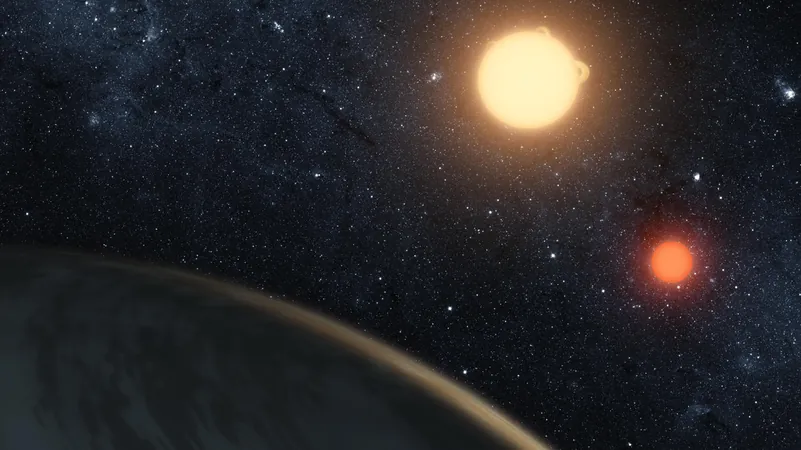
NASA Warns: Life on Iconic Desert Planets of Sci-Fi May Be a Fantasy
2025-01-06
Author: Michael
Introduction
It's a cherished dream among science fiction lovers: alien life thriving on arid, desolate planets like those depicted in 'Dune' and 'Star Wars.' These desert landscapes, famously home to the menacing sandworms of Arrakis and the rugged terrain of Tatooine, seem so vividly alive in our imaginations. But according to fresh insights from NASA, fans may need to recalibrate their expectations, as the possibility of finding life on such planets is slimmer than fiction suggests.
Recent Findings
Recent research presented by NASA’s Habitable Worlds Observatory project at the American Geophysical Union’s 2024 annual conference reveals that even in so-called habitable zones—regions around stars where conditions might allow for liquid water—desert planets face significant challenges in sustaining life. Scientists argue that the way these planets lose their water plays a crucial role in their habitability, casting doubt on the classic sci-fi landscapes we adore.
Water Availability and Planetary Stability
Haskelle Trigue White-Gianella, a Ph.D. student at the University of Washington, shared that while planets like Earth, which brims with liquid water, have maintained a stable climate for approximately 4.5 billion years, those with limited water appear to be at risk. 'Even if a planet is in the habitable zone, if it has too small a water inventory, it transitions to an uninhabitable state,' White-Gianella explained.
The data indicates that planets with less than 10% water coverage may face catastrophic climate instability. This insight aligns with theories about Venus, where the intensification of solar activity led to a boiling away of its oceans, potentially eliminating any chance of life. Such scenarios suggest that planets similar to Tatooine and Arrakis would need to retain substantial water to prevent becoming uninhabitable wastelands.
The Universe of Dune and Tatooine
But what about the celestial wonders of 'Dune'? The books tell us Arrakis orbits Canopus, a bright giant star with a brief lifespan of just a few hundred million years—far shorter than the time required for life as we know it to evolve. Adding another layer to this tapestry of speculation is Kevin Grazier’s work, where he proposed that the sandworms, rather than being naturally evolved, might have been introduced from another world, challenging the narratives fans love.
Tatooine bears its own burdens; as the home of Jedi and smugglers alike, it showcases multiple organisms, such as the womp rat and the mighty krayt dragon. Yet, NASA's research suggests that such creatures might not withstand a dramatic desertification process.
Conclusion
The narrative that these desert planets—so integral to beloved science fiction franchises—could not realistically support life is a hard pill to swallow for fans. As White-Gianella pointed out, 'To conclude, [these types of] sci-fi fiction worlds are probably not real.' For aficionados dreaming of galactic adventures, it's a bittersweet revelation: while the fantasy of life on desert planets remains thrilling, the science behind it tells a different, less optimistic story.
But fear not! Perhaps our exploration of other celestial bodies—like Saturn's intriguing moon Titan, which features organic sand dunes—will surprise us with new discoveries that defy even the most imaginative narratives of science fiction. With NASA's 'Dragonfly' mission set for 2028, there’s still hope that the universe may hold secrets far beyond our current understanding, and who knows? The dream of finding alien life might not be as distant as it seems!



 Brasil (PT)
Brasil (PT)
 Canada (EN)
Canada (EN)
 Chile (ES)
Chile (ES)
 Česko (CS)
Česko (CS)
 대한민국 (KO)
대한민국 (KO)
 España (ES)
España (ES)
 France (FR)
France (FR)
 Hong Kong (EN)
Hong Kong (EN)
 Italia (IT)
Italia (IT)
 日本 (JA)
日本 (JA)
 Magyarország (HU)
Magyarország (HU)
 Norge (NO)
Norge (NO)
 Polska (PL)
Polska (PL)
 Schweiz (DE)
Schweiz (DE)
 Singapore (EN)
Singapore (EN)
 Sverige (SV)
Sverige (SV)
 Suomi (FI)
Suomi (FI)
 Türkiye (TR)
Türkiye (TR)
 الإمارات العربية المتحدة (AR)
الإمارات العربية المتحدة (AR)